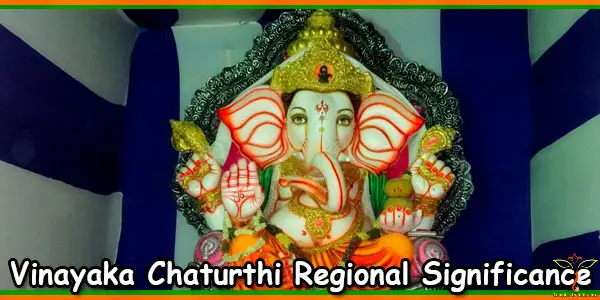The festival of Ganesh Chaturthi, popularly known as Vinayaka Chaturthi, is widely celebrated throughout India. It is a celebration of re-birth of Lord Ganesh. The regional significance of Ganesh Chaturthi varies slightly in different states as per the different traditions, customs and cultures prevailing there.
Significance of Ganesh Chaturthi in Maharashtra:
Celebration of Ganesh Chaturthi varies slightly in different states depending on their culture and traditions. In Mumbai and other places of Maharashtra the festival is celebrated for ten days with the peal of trumpets. Thousands of devotees gather at the famous Siddhivinayak temple in Mumbai during the festival. Expert artisans create huge clay idols of Ganesh several days or months before the commencement of the festival.
The city, filled with full of enthusiasm, becomes vibrant with wonderful illumination and reverberation of the famous slogan Ganapati Bappa Morya. In Maharashtra the Priests perform the rituals of Pran Pratishtha and Shodashopachara. Pran Prathistha involves the chanting of mantras and slokas to invoke life into the clay idol. Shodashopachara is a ritual in which Lord Ganesha is worshipped in sixteen different ways. At the end of the celebration, on Anant Chaturdashi, the idol is carried in a procession through the streets with colorful cultural display, excitement and enthusiasm and finally immersed in water. In Maharashtra, the delicious festival food include Modak, Patholi, Karanji, Puran Poli, and many more.
Significance of Ganesh Chaturthi in Tamil Nadu:
In Tamil Nadu, Ganesh Chaturthi is popularly known as Pillayar Chaturthi. It is celebrated in the Tamil month Avani. On the fourth day, after the appearance of new moon, the devotees of Tamil Nadu celebrate this festival with full of energy and passion. Kaliman Pillayar is a ritual in which the clay idols of Ganesh are decorated with Bermuda grass (asarukampul). Some temples are fully decorated with coconut. The favorite delicacies are Vella kozhukattai, made of rice parcels stuffed with jaggery and coconut, and uppu kozhukattai, made of rice parcels stuffed with lentil. In South India, the celebration slightly varies in the states of Kerala, Andhra Pradesh and Goa.

Significance of Ganesh Chaturthi in Kerala:
In Kerala, Ganesh Chaturthi is also known as Lamboodhara Piranalu. It falls in the Malayalam month Chingam. Here the ritual of milk Abhishekam is performed. With the display of colourful rangolis, songs, dance and art forms people celebrate the festival with high spirits and devotion. Delicacies include Modak, vundrallu made of steamed rice-flour, vadapappu or soaked moong lentils, and so on.
Significance of Ganesh Chaturthi in Goa:
In Goa, Ganesh Chaturthi is known by the name Chavath and Parab. Women observe fast on the third day of the month of Bhadrapada and worship Lord Shiva and Parvati. Lavish feasts are served during this festival. Devotees of Goa perform the ritual of worship in the form of leaves (Patri). Unlike the other Southern states, the celebrations in Goa are very modest in nature, where it is celebrated in home rather than a public event. Nevri, made of rice flour stuffed with coconut and sugar, is a very popular festival delicacy in Goa.
Ganesh Chaturthi’s regional significance lies in the fact that even though this festival is celebrated in a number of ways throughout the country according to their different customs and traditions, the main principle behind the celebrations remains the same. That is, the powerful Lord Ganesha abolishes every obstacles in the path to success and ensures prosperity and fortune to his devotees.
